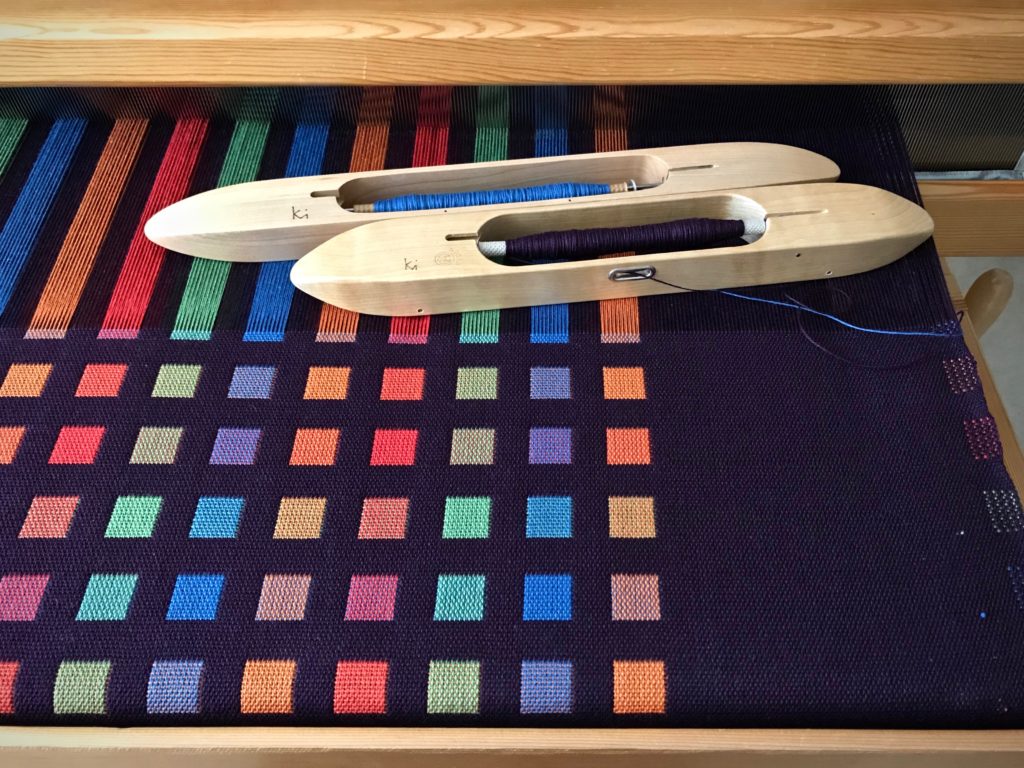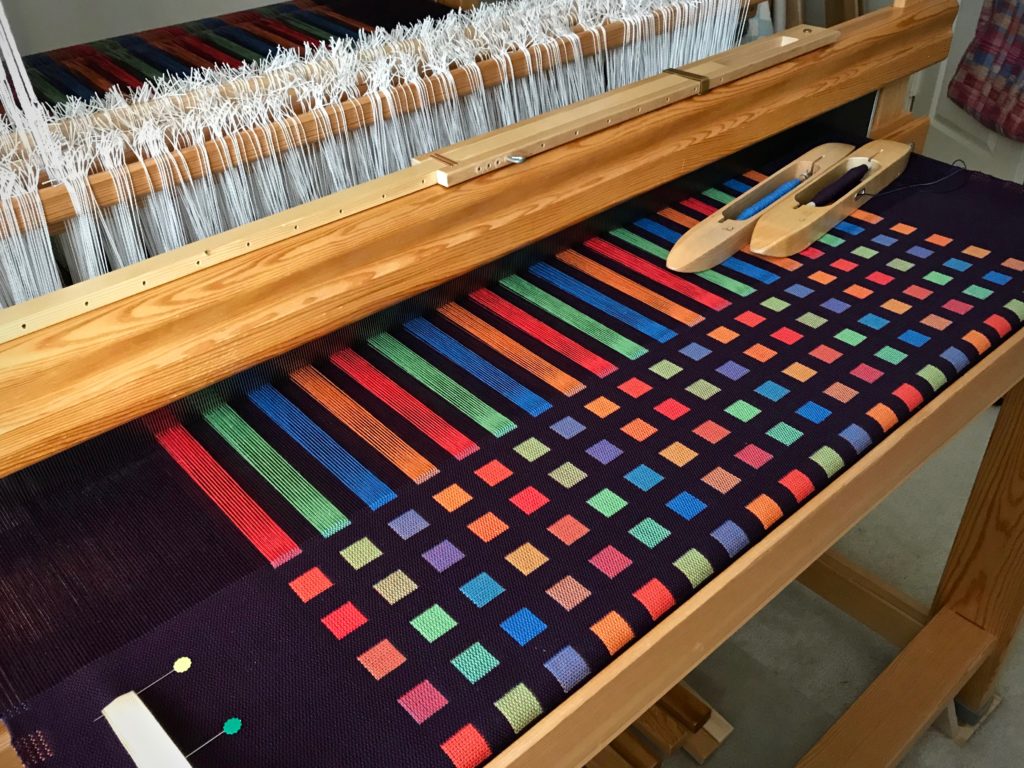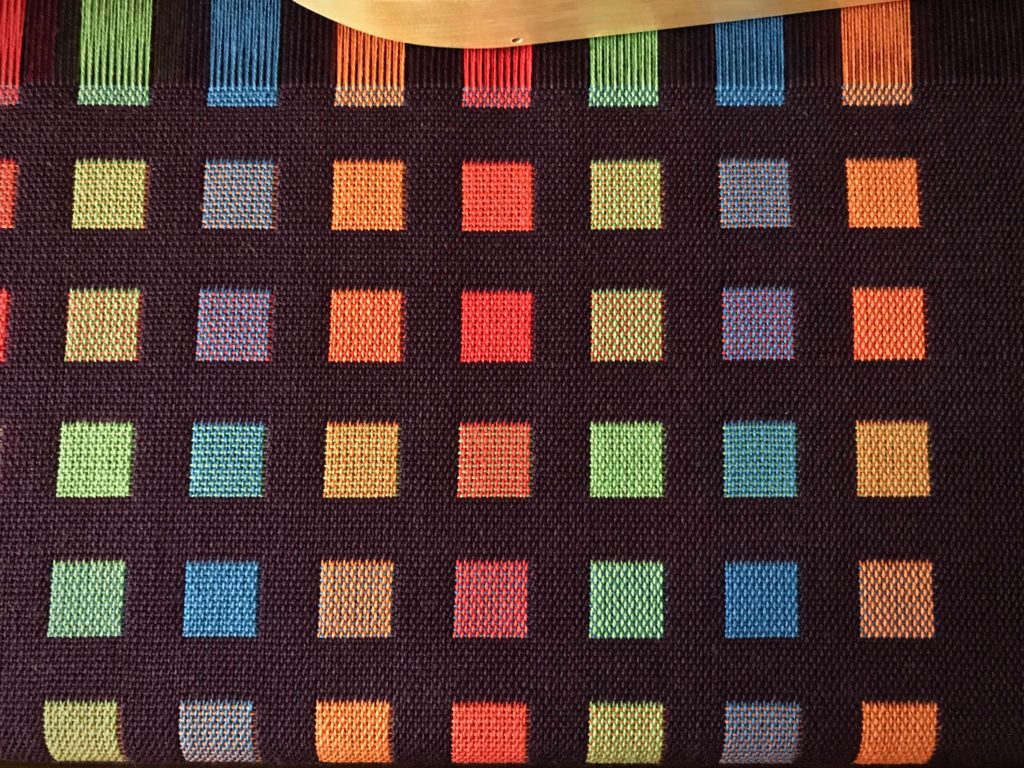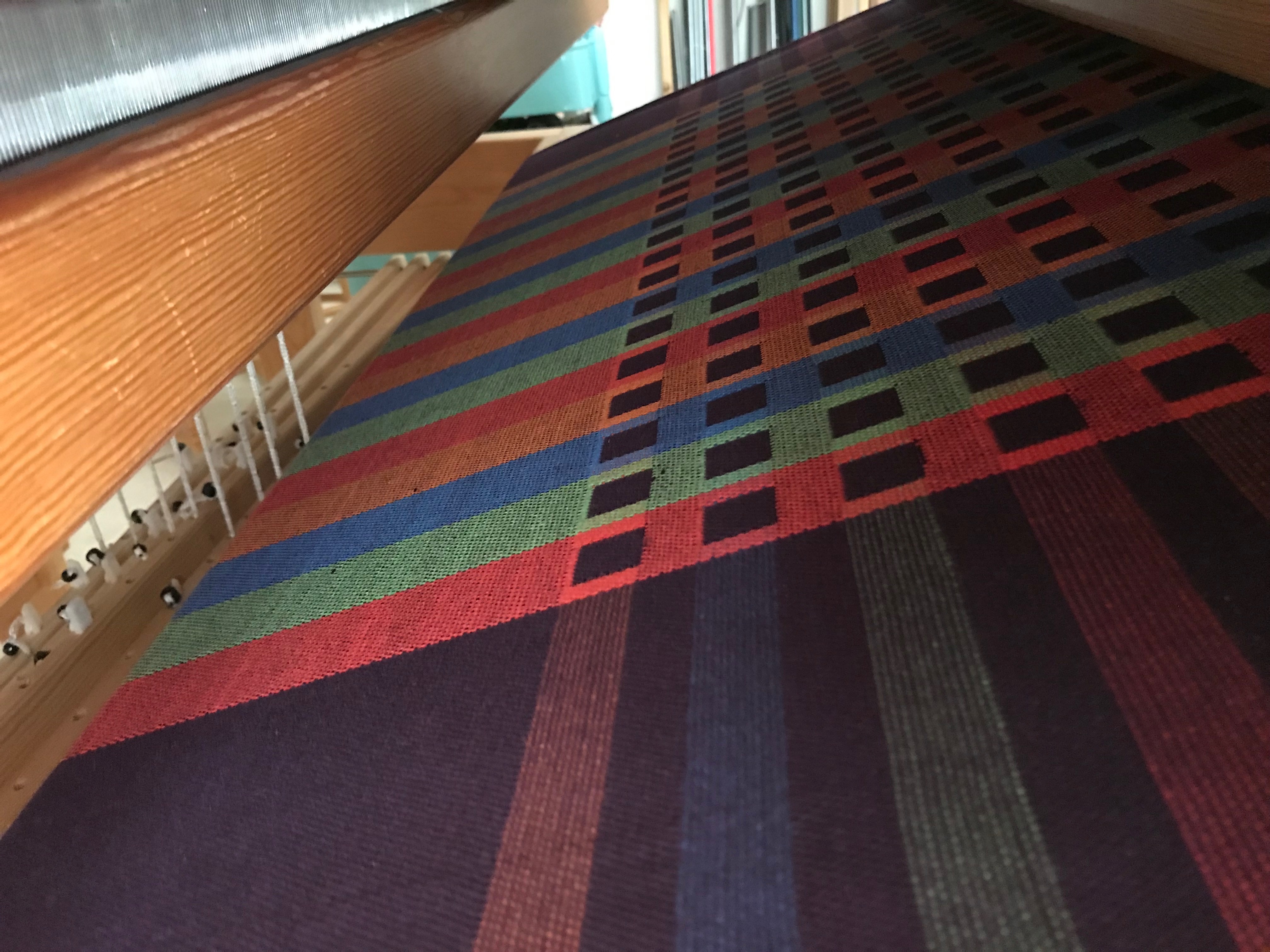Two layers of cloth exchange places in this double weave structure. One layer of warp is solid deep plum. The other layer has stripes of bold colors. Clean lines occur where the layers switch places. So, with deep plum weft alternating with orange, blue, green, and red weft, we get a message written in clearly-defined blocks: Be invigorated with vibrant color!



Message. We have a message from heaven. When Jesus came to earth, he not only brought the message, he was the message. Not that we should try to be good like him. Nor that we are already good enough. But that he, the direct link to heaven, would suffer the consequences for all our misdeeds. And rise again. He willingly switched places with us—the great heaven and earth exchange. This good message brings hope and grace to all of us who live on this earthly layer. Thanks to our Grand Weaver’s faithful love, we are woven into a vibrant-color existence through faith, on this layer and the next.
May you see your surroundings in living color.
Joyful weaving,
Karen

This is terribly interesting. The colors are so delicate.
Hi Meg, The contrast between the deep plum and the other colors has a surprising effect. Working with colors never grows old!
All the best,
Karen
Hi Karen,
I love doubleweave, so many interesting effects possible. This is a terrific project.:)
I am so pleased I discovered your blog.
Kind regards
Chris
Hi Chris, Doubleweave is fascinating! This project stretches me—literally, side to side—making it a delightful challenge to weave.
I’m delighted you found your way here!
Happy weaving,
Karen
This is just beautiful! And timely. I am currently trying to design a similar doubleweave windows draft for a throw and have come across 2 sources that explain the block design differently. I have been trying to work this out in my head, one vs the other, in my planning process and how to apply it. I confuse myself and have had to keep setting it aside and studying it again later. Seeing this post of yours, I just now realized that you have been posting about this same block design all along and your pictures are now helping me work through it. I am planning a gray background with 10-11 shades of blues, greens, purples in the “windows” for the front. I may vary the heights and widths of the windows throughout the throw…haven’t progressed to that decision yet.
My first source for this project is in the book Loom Controlled Double Weave by Paul R. O’Connor, on pp. 42-43.
The second source I found online: https://www2.cs.arizona.edu/patterns/weaving/webdocs/opr_8s.pdf pp. 2-4
The two may actually be the same thing, just explained differently, so I was having a little difficulty figuring it out in my head. In the second, they are using Dark/Light instead of color letters. If I use gray for both the D and L in Block A, I’m thinking it would be the same as O’Connor’s threading. If I used the second threading, and used gray as D and my colors as L throughout, I think it would only change the appearance of the back. Am I right? If I want gray to predominate on both sides, I think I just follow O’Connor’s threading, but I think the second source (using D/L) shows the tie-up in conjunction with the treadling and would be more helpful in setting up my loom.
I went back through your previous posts about your throw and it appears you used the second approach, the D/L threading in both blocks A and B. I would really like to know what the back of yours looks like, but I still think I want to follow the O’Connor threading. It has been incredibly helpful looking back at your posts at this point in my design process! I feel like a light went on and suddenly it is making sense to me.
Thank you so much!!
Hi Janet, I haven’t studied doubleweave like you have. The draft I’m using is similar to the one in the arizona.edu file. I don’t have the O’Connor book to reference. The draft I am using is from The Big Book of Weaving, by Laila Lundell, p. 176, if you want to compare it. I wound the warp with 2 ends–plum, plum; and plum, other color. The threading alternates the plum with the other color in the blocks with squares.
I’ll post a picture of the back in a little bit.
It’s great when a light comes on like that! Hooray!
Karen
Janet, Here’s a picture of the back side of the fabric!

Karen
Karen, thank you for the view of the back! I think I understand the difference in the 2 threadings now. I also pulled out another book I have (and forgot to look at–head slap), Doubleweave by Jennifer Moore), and found an example done using the O’Connor threading that also showed how the back looks in that case.
When I first started my comment above, it was going to be asking you a lot of questions to help me make sense of it all. As I typed, that light kept getting brighter, and I answered most of my own questions before they even got typed, so I ended up with a completely different comment than when I started. So, without even knowing it, you enlightened me! Sorry, I do tend to run on when I get wound up….
Don’t mistake me for someone that knows what I’m doing. I think I am more of a technician (& perfectionist) than a creative artist, so I have to understand how things work (and then modify them). I do it when I sew also. Unfortunately, it means I spend more time planning (or “studying”) my projects than actually doing them. I would probably learn more if I just dove in and made things, but I guess I’m not made that way.
I have put a request in to the library for the Lundell book, and I imagine I will end up buying it. As a technician, I am also a collector of resources and tools.
Love your blog! You are an inspiration.
Janet, There are many different learning styles. It’s great that you understand how you are wired! I think I’m also a technician to some degree. I enjoy systems and knowing how something works, and being able to alter that, too. But I’m also finding that I learn a lot by doing, even when I don’t understand. My mistakes — like the several I’ve made with this project — take me to greater understanding and experience. Learning is a lifelong pursuit. I’m glad about that!
Karen
Love those colors, Karen! The purple becomes a neutral background.
Hi D’Anne, I never would have thought of purple being a neutral, but you’re right. It’s almost like a deeply colored black that sets off the other colors.
Thanks,
Karen